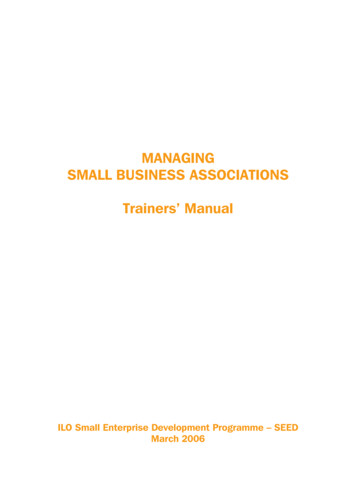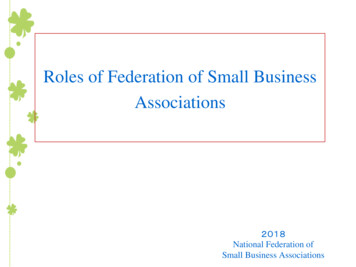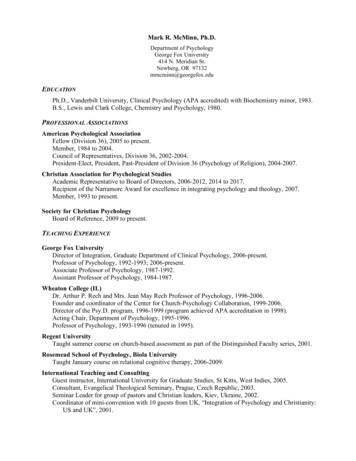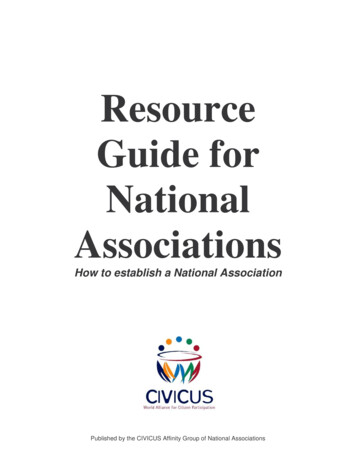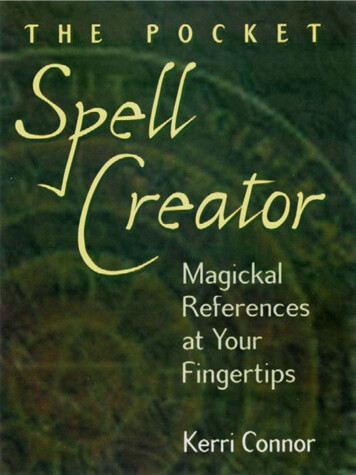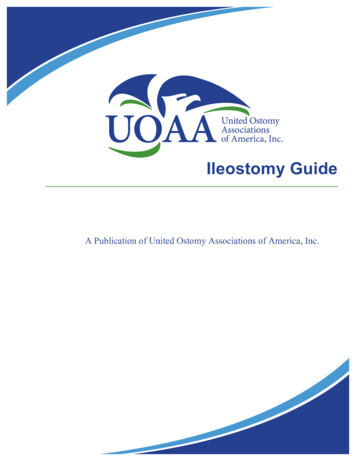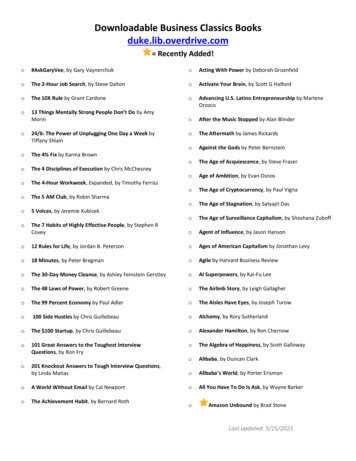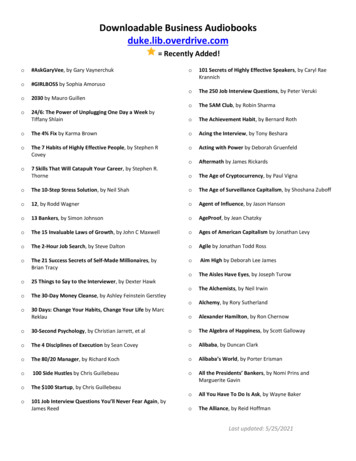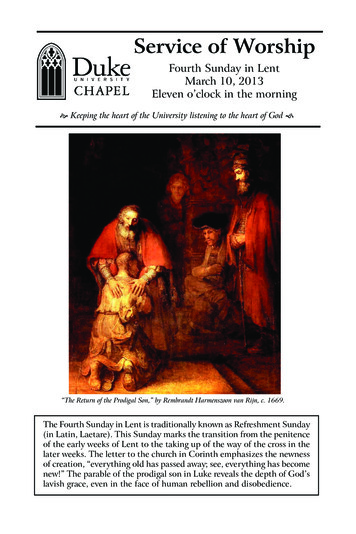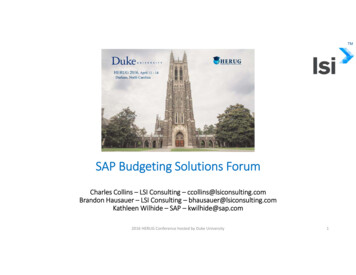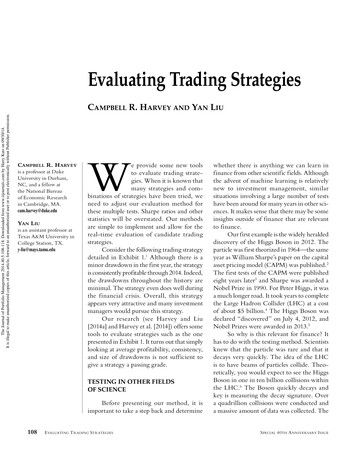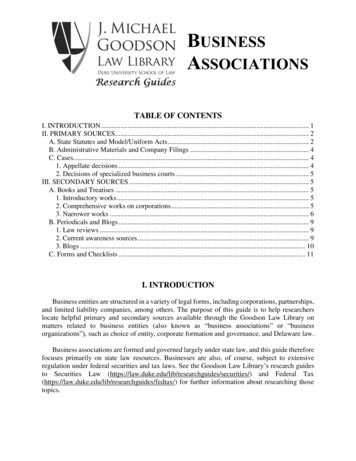
Transcription
BUSINESSASSOCIATIONSTABLE OF CONTENTSI. INTRODUCTION . 1II. PRIMARY SOURCES . 2A. State Statutes and Model/Uniform Acts . 2B. Administrative Materials and Company Filings . 4C. Cases. 41. Appellate decisions . 42. Decisions of specialized business courts . 5III. SECONDARY SOURCES . 5A. Books and Treatises . 51. Introductory works . 52. Comprehensive works on corporations . 53. Narrower works . 6B. Periodicals and Blogs . 91. Law reviews . 92. Current awareness sources . 93. Blogs . 10C. Forms and Checklists . 11I. INTRODUCTIONBusiness entities are structured in a variety of legal forms, including corporations, partnerships,and limited liability companies, among others. The purpose of this guide is to help researcherslocate helpful primary and secondary sources available through the Goodson Law Library onmatters related to business entities (also known as “business associations” or “businessorganizations”), such as choice of entity, corporate formation and governance, and Delaware law.Business associations are formed and governed largely under state law, and this guide thereforefocuses primarily on state law resources. Businesses are also, of course, subject to extensiveregulation under federal securities and tax laws. See the Goodson Law Library’s research guidesto Securities Law s/) and Federal /) for further information about researching thosetopics.
Online collections of materials on business associationsBloomberg, Lexis Advance, and Westlaw all offer comprehensive business associationspractice centers or areas, which are convenient starting places for research. These practice centerscollect both primary and secondary sources. On Bloomberg Law, the Corporate practice center includes state and federal cases,statutes, and regulations, Delaware Chancery Court dockets, drafting guides, forms,and secondary sources from the American Bar Association, Practising Law Institute,and Bloomberg BNA, among others. In the Corporate Law Resource Center onBloomberg BNA, researchers can find news, portfolios, and practice tools like sampledocuments and checklists, along with cases and statutes.On Lexis Advance, the Business & Corporate Law practice area collects cases,statutes, regulations, and secondary sources. Lexis Practice Advisor (accessible underthe tiles to the left of the Lexis Advance Research button) offers a transactional viewof business associations materials in its Corporate and M&A and state-specificBusiness & Commercial practice areas. The state-specific business law materialspresently include California, Florida, New York, and Texas, with more states to beadded in the future.On Westlaw, cases, statutes, regulations, secondary sources, and forms can be foundboth in the Corporations and Corporate Governance practice areas. Additional forms,practice notes, and checklists are available in the Corporate and M&A practice area inPractical Law.II. PRIMARY SOURCESA. State Statutes and Model/Uniform ActsMany states’ laws on the formation and governance of business entities are based on model oruniform acts. The Delaware Corporation Law (8 Del. Code §§ 101-398,http://delcode.delaware.gov/title8/c001/) also serves as a model for some states.The Model Business Corporation Act (“MBCA”) from the Corporate Laws Committee ofAmerican Bar Association’s Section of Business Law serves as a drafting guide for statelegislatures, and many states have adopted current or previous versions of the MBCA. The currenttext of the MBCA (2016 revision) is available in print (KF1404 .A15 A44) and on BloombergLaw. A free, unannotated version of the MBCA can also be found at the Corporate rg/content/dam/aba/administrative/business law/corplaws/2016 mbca.pdf).The Model Business Corporation Act Annotated, 4th ed. (KF1414 .A513 and on BloombergLaw), is generally preferred for research purposes because along with the text of the Act and2
official commentary, it also provides lists of states that have adopted each section, case citations,and statutory comparisons between the MBCA and each state’s statutes as adopted. It has not,however, been updated yet to reflect the 2016 revision of the MBCA.The Uniform Law Commission (“ULC”) and the American Law Institute have promulgatedseveral uniform laws pertaining to unincorporated business entities (i.e., entities other thancorporations), including the Revised Uniform Limited Liability Company Act, the UniformPartnership Act, the Uniform Limited Partnership Act, and the recent Uniform BusinessOrganizations Code (“UBOC”). To see all of the acts pertaining to business entities at the ULC’swebsite, (http://uniformlaws.org/Acts.aspx), select “Business Organizations & Regulations” underCategory.The current legislative status of each uniform law (i.e., which states have introduced or adoptedeach act) can be found at the individual act’s page on the ULC’s website. See, for example, theUBOC page (http://www.uniformlaws.org/Act.aspx?title Business%20Organizations%20Code).Each page also provides the text of the act and a “Legislative Information Kit,” which includes asummary of the legislation and information about the reasons it should be adopted.Current and historical versions of uniform laws are also available comprehensively in theUniform Laws Annotated (Reference KF879 .A45 U51 and on Westlaw). This collection includesthe text of each act, official comments, cross references to West topics and key numbers andCorpus Juris Secundum, and notes on state adoptions and variations. In print, the uniform laws onbusiness associations are found in the Business and Nonprofit Organizations and AssociationsLaws volumes.Once adopted, state statutes on business associations are found in state codes. Annotatedversions of every state’s codes are available in print on the third floor of the library and on LexisAdvance and Westlaw. More narrowly, databases containing only the portions of state codesdealing with business entities are available in the practice centers on Bloomberg Law, LexisAdvance, and Westlaw described in Part I above. Of particular note is the State Forms of Businesssection of the Corporate practice center on Bloomberg Law, which quickly takes researchers tobusiness entity laws and corporate forms for all 50 states and the District of Columbia. Similarly,links to free, unannotated versions of all states’ corporate statutes are also available at the CornellLegal Information Institute (https://www.law.cornell.edu/wex/table corporations).To locate state statutes on narrower aspects of the law of business associations, researchers canuse 50-state surveys. On Bloomberg Law, 50-state surveys on limited liability companies, limitedpartnerships, and benefit corporations are found under Chart Builders & Surveys in the Corporatepractice center. Additional 50-state surveys on corporate compliance, governance, legaldepartments, and forms of business are available in the Corporate Law Resource Center onBloomberg BNA. The 50 State Surveys: Statutes and Regs database on Lexis Advance coverslaws and regulations pertaining to several types of business associations, including corporations,limited liability companies, limited liability partnerships, non-profits, and professionalassociations. Finally, on Westlaw, surveys on issues such as corporate formation, dissolution, andshareholder protections are available in the 50 State Statutory Surveys database. To identifyadditional 50-state surveys and secondary sources that function as 50-state surveys on very narrow3
issues, consult Cheryl Nyberg’s Subject Compilations of State Laws (Reference KF1 .F67 and onHeinOnline).B. Administrative Materials and Company FilingsBusiness entities that are either incorporated or doing business in a state are typically regulatedby the corporations division of the state’s Secretary/Department of State. State regulationspertaining to business associations are located in state administrative codes, in print or online.Current state administrative codes and registers are available comprehensively on Bloomberg Law,Lexis Advance, and Westlaw.Narrower databases containing only state regulations and other administrative materialsdealing with business associations are also available in the practice centers on Lexis Advance andWestlaw described in Part I above. Some states’ corporations divisions also make current businessregulations available on their websites. Regulations of the North Carolina Secretary of State’sCorporations Division are located in Title 18, Chapter 4 of the State of North CarolinaAdministrative Code, which is available in print in the State Codes area or free online at the //reports.oah.state.nc.us/ncac.asp?folderName 04%20-%20Corporations%20Division).Business entities are required to make annual filings with the corporations division of theSecretary of State in the state(s) in which they are incorporated or licensed to do business. Recentannual filings and other company documents, like charters/articles of incorporation and bylaws,are increasingly available online at many corporations divisions’ websites. (Documents datedbefore the early 2000s are often available only on microfiche.) At the North Carolina CorporationsDivision’s website (https://www.sosnc.gov/search/index/corp), which is typical of such sites, userscan search by company name to obtain company filings and other documents, as well asinformation about a company’s corporate citizenship, status, address, officers, and registeredagent. (For information about publicly-traded companies’ required federal securities filings, seethe library’s research guide to Securities Law, /.)C. Cases1. Appellate decisionsState and federal appellate decisions on matters related to business associations can be foundwith other cases in standard state, regional, and federal reporters, in print and online. In addition,each of the practice centers discussed in part I above provides access to subject-specific databasesof state and federal cases.4
2. Decisions of specialized business courtsSome states have created separate trial courts (or separate dockets within trial courts of generaljurisdiction) to handle commercial and business disputes, with the goal of speedy resolution ofcases by judges with expertise in business and commercial law. The Delaware Court of Chancery,a court of equity established in 1792, has long been known as “the nation’s principal forum for theresolution of internal corporate governance disputes.” Decisions of the Delaware Chancery Courtcan be found in West’s Atlantic Reporter, in print or online. More recently, the Delaware SuperiorCourt established a Complex Commercial Litigation Division, which handles business disputesnot covered by the Chancery Court’s jurisdiction. Decisions of Delaware courts of all levels areavailable at the state court system’s website (http://courts.delaware.gov/opinions/).In the last 20 years, many other states have followed Delaware’s lead in establishingspecialized business courts. For example, the North Carolina Business Court(http://www.ncbusinesscourt.net/) hears cases “involving complex and significant issues ofcorporate and commercial law.” A comprehensive list of links to business and commercial courtscan be found at the website of the Business Courts Subcommittee of the ABA’s Business LawSection m CL150011), and recent opinionsare often found at the courts’ websites.III. SECONDARY SOURCESA. Books and Treatises1. Introductory worksResearchers new to the law of business associations may wish to consult a study guide. Studyguides in the law library’s collection include Agency, Partnership, and the LLC in a Nutshell,6th ed. (Reserves KF1375 .Z9 H95 2016), Business Associations in a Nutshell, 3d ed. (ReservesKF1355 .S53 2010), The Law of Corporations in a Nutshell, 7th ed. (Reserves KF1414.3 .H352016), Mastering Corporations and Other Business Entities, 2d ed. (KF1355 .H37 2016),
business associations are found in the Business and Nonprofit Organizations and Associations Laws volumes. Once adopted, state statutes on business associations are found in state codes. Annotated versions of every state’s codes are available in print on the third floor of the library and on Lexis Advance and Westlaw. More narrowly, databases containing only the portions of state codes .
